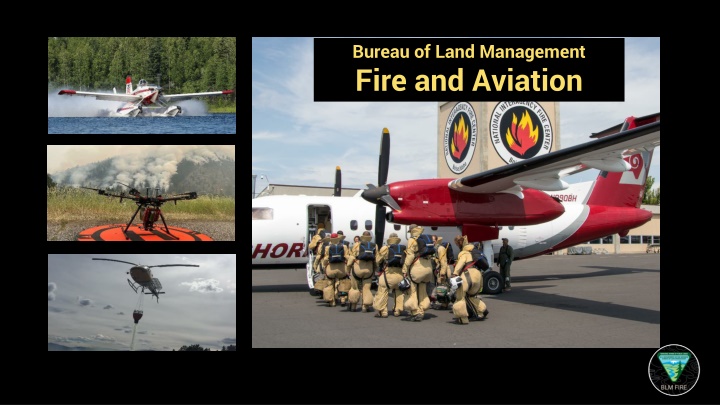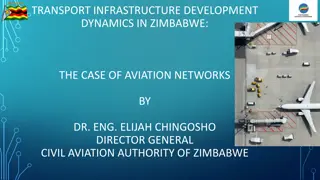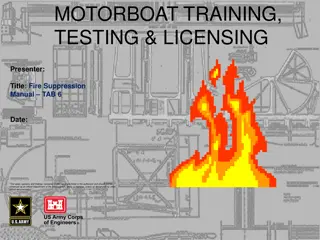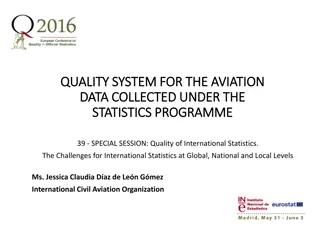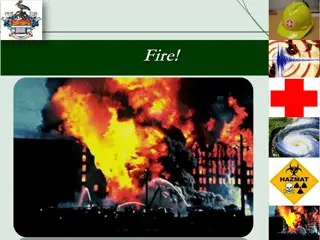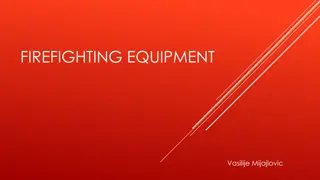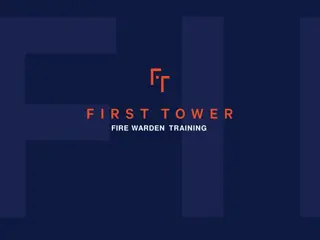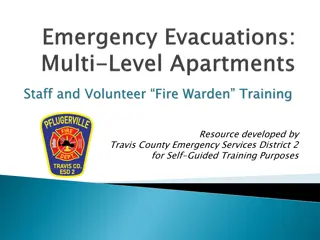BLM Fire and Aviation Program Overview
The Bureau of Land Management (BLM) Fire and Aviation program is responsible for managing wildfires on over 245 million acres of public lands. The program utilizes a variety of aircraft, including helicopters, SEAT, and Fire Bosses, to support wildfire management and resource needs. BLM's aviation fleet plays a crucial role in initial attack efforts, water drops on wildfires, aerial reconnaissance, and supporting non-fire missions in remote locations. With a focus on fire safety and resource management, the BLM Fire and Aviation program is an integral part of the U.S. Department of the Interior's wildfire management efforts.
Download Presentation

Please find below an Image/Link to download the presentation.
The content on the website is provided AS IS for your information and personal use only. It may not be sold, licensed, or shared on other websites without obtaining consent from the author.If you encounter any issues during the download, it is possible that the publisher has removed the file from their server.
You are allowed to download the files provided on this website for personal or commercial use, subject to the condition that they are used lawfully. All files are the property of their respective owners.
The content on the website is provided AS IS for your information and personal use only. It may not be sold, licensed, or shared on other websites without obtaining consent from the author.
E N D
Presentation Transcript
Bureau of Land Management Fire and Aviation
Overview The BLM Fire and Aviation program is the largest and most complex fire program within the U.S. Department of the Interior. BLM Fire is directly responsible for fire management on more than 245 million acres of public lands nationally. Aircraft are a mix of bureau-owned, contracted, or obtained on a call-when-needed basis. Aircraft operations support the BLM mission for wildfire and resource management needs. When aircraft are not being used to support wildland fires, they help other BLM programs.
BLM Aviation Flight Hours 10- year average of 22,623 flight hours per year (2013-2022) 67 67% Fixed wing 84 84% Fire related Program supported Type of aircrafts 16 16% Natural resources/ law enforcement 33 33% Rotor wing
BLM Fire Aircraft Types BLM Fire Aircraft Types 34 25 4 Single engine airtankers Helicopters Fire bosses 26 Tactical aircraft 30 Remote aircraft systems
BLM Helicopters Help with initial attack as first resources on a fire to bring firefighters or cargo to remote locations. Can drop water on wildfires. Nearly 3 million gallons of water delivered during fire year 2022. Provide fire reconnaissance. Assist with aerial ignition support for prescribed fires or wildfire incidents. Support non-fire missions in remote locations. Examples: BLM Wild Horse and Burro program, cadastral services in Alaska
Single Engine Air Tankers (SEAT) and Fire Bosses Single engine air tankers are land-based aircraft are used to drop retardant on wildfires. Fire bosses are amphibious aircrafts that can float. These aircraft scoop water to drop on wildfires. There are a number of airtanker and SEAT bases to support operations across the country from Alaska to Arizona. Typical SEAT and Fire Boss loads are 600-800 gallons depending on the amount of fuel on board.
Airtanker/SEAT Bases BLM hosts 8 permanent large airtanker bases around the country. BLM hosts around 16 permanent SEAT bases.SEATs utilize smaller airports that assists in a broader response and coverage area. Temporary Mobile Retardant Bases (MRBs) may be set up at strategic locations to support initial attack or extended attack incidents. Airtanker/SEAT Bases host many other aerial fire resources that can include air attack, leadplanes,helicopters, and other tactical aircraft. They provide retardant, fuel, and other logisticalsupport needs.
BLM Leadplanes Leadplanes fly ahead of larger aircrafts like airtankers to assist them with retardant drops. They also check the route and plan the exit path since these smaller planes are easier to maneuver. Leadplane pilots utilize smoke to indicate where the larger aircraft should drop retardant. The smoke deployed by the leadplanes also helps airtankers gauge what the wind is doing. BLM operates 3 contracted leadplanes and owns two aircrafts. Unique to BLM s program: All BLM pilots have a background in wildland fire. Every pilot started as wildland firefighters and have worked their way towards leadplane pilot certification.
BLM Smokejumper Planes Deliver smokejumpers and cargo by parachute to remote fire locations in Alaska and the lower 48. Aircrafts fly at 3,000 feet above ground level, allowing smokejumpers to safely exit the plane near a wildland fire. Two BLM smokejumper bases: Great Basin Smokejumper base in Boise, Idaho Alaska Smokejumper base in Fairbanks, Alaska.
BLM Remote Aircraft Systems Offers a bird s eye view for operations, increasing safety and efficiency. Aircraft have the unique ability to fly low, slow, and for long periods of time while collecting high- resolution imagery and data. Used to identify possible hazards and learn more about the fire s activity to help make informed decisions: Collect near real-time video Assist with intelligence, surveillance, and reconnaissance information Help with fire mapping, detecting hotspots (active parts of a fire) and spot fires (fires ignited outside the perimeter of the main fire) Infrared sensors help at night
